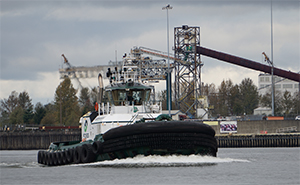On a cool, gray November morning, the tugboat Carolyn Dorothy glided quietly into the Willamette River near Portland, Ore. Capt. Kevin Gabriel soon had the vessel up to 7 knots, yet the engines were conspicuously silent.
The 5,000-hp vessel, one of two hybrids in Foss Maritime’s fleet, was built nine years ago at the Seattle company’s shipyard in Rainier, Ore. At the time, it was the first diesel-electric hybrid tug working in the United States, although Foss has since retrofitted Campbell Foss with a similar power plant. Carolyn was transferred to Portland in late 2016 after eight years in Los Angeles.
In mid-November, Gabriel and other Portland-based Foss captains were still training on its “Green Assist” hybrid propulsion system consisting of batteries, generators and its main engines. The system has four modes — stop, idle, transit and assist — that the captain can choose from for maximum efficiency.
Carolyn’s Rolls-Royce azimuthing stern drives can be powered by its twin Cummins QSK50 Tier 2 main engines or by two Siemens motor generators. The tug also can pull electrical power from 28 rechargeable batteries mounted in the stern. A complex electrical system controlled by the captain links these components together.
Typically, the mains are used only during jobs that require maximum horsepower, such as docking and ship assist. While in transit, motor generators turn the z-drives, propelling the tug at up to 9 knots. Battery power kicks in when the vessel is idled or stopped. The motor generators charge the batteries when not in use.
Although the Green Assist system was intended to reduce emissions, it also cuts work time and maintenance on the Cummins engines, said Paul Hendriks, Foss’ Portland-based operations manager.
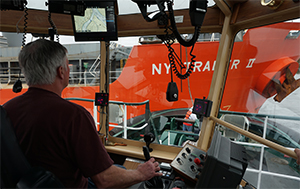 |
|
Capt. Kevin Gabriel holds Carolyn Dorothy against the loaded bulker NY Trader II while deck hand/engineer Chris Jakovac works the line. |
Gabriel found plenty to like during his time at Carolyn’s controls, particularly the Markey winches and nimble z-drives. “This is the best (vessel) I’ve been on in my career,” said Gabriel, who joined the company in 1979 at age 21. “To have this is so cool compared to a conventional tug.”
Earlier that morning, Foss dispatchers assigned Carolyn to the Columbia Grain terminal about a mile downriver from its office on the Willamette. The first job called for moving and repositioning a loaded bulk carrier for outbound transit, and immediately afterward it would dock an empty tanker at the same terminal.
Carolyn reached Columbia Grain, located near the confluence of the Willamette and Columbia rivers, at about 1120. The 583-foot bulker NY Trader II was nearly finished loading and the Columbia River Pilot was already on board. Another Foss tug, the 4,000-hp Peter J. Brix, was positioned off the ship’s starboard quarter.
Jobs like this one keep tugboat crews busy on the Columbia and Willamette rivers. A lot of cars, minerals and agricultural products still move through the Port of Portland, but activity has fallen in recent years. In 2012, the port averaged 45 oceangoing ships a month, while last year that number fell to less than 34, Port of Portland data shows. The container business has essentially dried up, a shift led by Korean shipper Hanjin’s departure in early 2015.
Statistics from the Port of Portland tell the full story. Break-bulk cargo fell more than 97 percent from 2012 to 2016, when less than 23,000 tons moved through the port. Over the same period, total container activity fell from 183,000 TEUs a year to just 1,725 in 2016. It’s not all bad, though. Total cargo volumes rose 22 percent from 2015 to 2016 to 10.2 million tons.
The port handled 291,242 cars in 2016, about 2.5 percent more than 2012 — and mineral tonnage increased by almost double that margin during that same five-year span. Still, grain is the most important commodity in the region, and terminals line the river from Portland to Longview, Wash. Depending on the season, these facilities load wheat, corn, soybeans, lentils and other crops. Much of the harvest reaches the terminals by barge.
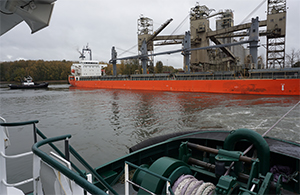 |
|
Carolyn Dorothy and the 4,000-hp Foss tug Peter J. Brix pull NY Trader II away from the Columbia Grain terminal on the Willamette River. |
“Grain is king on the river,” said Scott Merritt, Foss’ chief operating officer. “The river rises and falls with the health of the export market for our agricultural products.”
He considers Portland as something of a niche market, where companies weigh shipping locally against sending product to Seattle by rail. Foss entered Portland in 1993 with its acquisition of Brix Maritime. Business isn’t as robust today as in the early 1990s, when the region still held a bustling lumber and wood products business.
“The Portland market seems to have really slowed down,” said Capt. Steve Shaver, president of Portland-based Shaver Transportation, which does escort and docking work on the Columbia in addition to moving barges. “The grain and autos are just about the only things that aren’t really off.”
About a half-hour after Carolyn arrived at Columbia Grain, the Philippines-flagged NY Trader II was ready to go. The job was straightforward: The tugs would move the bulker off the docks, then swing the bow almost 180 degrees clockwise for outbound transit. Carolyn and Peter J. Brix made fast their lines and waited for the pilot.
Gabriel switched Carolyn into idle mode until the job started, when he’d fire up the main engines. “We’re holding against the ship now, but we’re just on batteries,” he said.
Gabriel switched to assist mode and the Cummins engines started, making available all 5,000 horsepower. The pilot ordered Carolyn to back at half-power and for the bulker to be moved slowly off the terminal, followed by an order to back at two-thirds power. With the vessel safely away from the docks, Peter J. Brix released its line while Carolyn continued pulling the bow around. On deck, the tug’s Markey DEPGF-42 winch with render-recover maintained constant tension on the 8.5-inch purple Plasma line.
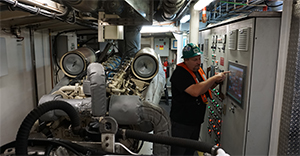 |
|
Capt. Dan Riser points out components in Carolyn Dorothy’s engine room. Above is one of the tugboat’s Cummins QSK50 mains. |
With the vessel nearly finished its clockwise spin, the pilot ordered Carolyn to back one-third, then to stop and shorten its line. Soon, the crew got the order to release the line. The job was done, and over radio Gabriel wished the bulker a safe trip.
Consolidation in recent decades has left three big companies working the Columbia and nearby waterways. Foss and Shaver share much of the escort and docking work, while Vancouver, Wash.-based Tidewater has a fleet of pushboats that move the lion’s share of barges. Shaver also has an active barging operation, and there are a handful of smaller operations left on the river.
The consolidation, combined with less work overall, has sharply reduced the region’s maritime work force. Capt. Dan Riser, a 29-year Foss employee and captain since 1994, recalled how union meetings many years ago would draw 130 deck hands, even as many others were on the job and could not attend. That same meeting today, he said, would draw about 15 people.
“There’s less work and less jobs, less boats and less people,” Riser said.
Even so, the towing companies are still big employers. Shaver has over 100 people serving ports in Longview and Kalama, Wash., as well as Greater Portland. The company has 12 tugboats and towboats in its fleet and more than twice that many barges. Foss has 57 mariners and shoreside support staff for its six tugs based in Portland, and it maintains a pilot launch in Astoria, Ore. Roughly 30 people work at Foss’ shipyard in Rainier, which is currently building Nicole Foss, the third of three 7,268-hp Arctic-class tugs.
Foss’ Fleet Monitoring Center in Portland employs another 15 people. The office provides dispatch for all of Foss’ West Coast operations, including busy ports in Los Angeles, San Francisco and Puget Sound. Its employees also monitor the worldwide fleet for TOTE Maritime and Tropical Shipping, two sisters in the Saltchuk family of companies.
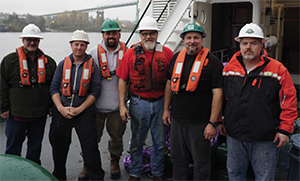 |
|
Foss Maritime employs 57 mariners and shoreside personnel at its Portland operation. From left are Paul Hendriks, Josh Thompson, David Chesnut, Chris Jakovac, Danny Riser and Kelly Bonnin. |
“We have 24-hour watch standers who not only dispatch and coordinate the movement of tugs in response to customer orders, but also monitor via AIS tracking all oceangoing vessels,” Merritt said. “They monitor weather and storms and can assist with shoreside management and route guidance.”
Carolyn proceeded about a half-mile downriver toward the mouth of the Willamette, where the tug met the incoming bulker Galleon, a 554-foot vessel registered in Panama. Riser relieved Gabriel at the controls for this job. He was plenty familiar with Carolyn, having delivered it from Southern California over five days in late October. The tug performed well, even during a period of rough weather off Eureka, Calif., where swells reached 14 feet.
As they approached Columbia Grain, Riser switched the tug from transit to assist mode and the Cummins mains came to life. Peter J. Brix lined up along Galleon’s starboard bow and Carolyn took position on the starboard quarter. At the bow, deck hand/engineer Chris Jakovac was ready to throw the messenger line to Galleon’s crew standing on deck several stories overhead.
With the lines connected, the tugs in place and the bulker lined up, the pilot gave the usual commands. The tugs began pushing the massive ship into its berth, and before long Galleon was docked and tied up along the terminal.
Riser switched the tug from assist mode back to transit mode, letting the generators provide propulsion for the ride back to Foss’ facility. Along the way, the tug passed marine terminals with piles of metal scrap and potash, a key ingredient in fertilizers.
Depending on the season, Riser and other Foss captains might work three or more jobs a day, although they can be spread between Portland and Longview, roughly 45 river miles downriver. After a quick stop back at the docks, Riser and crew were headed in that direction for a job in Kalama just as a slow drizzle began to fall.
But for longtime mariners like Riser and Gabriel, as well as the crew down below, there are worse ways to spend the day.

